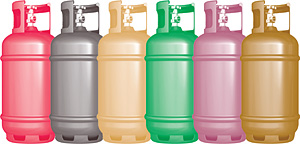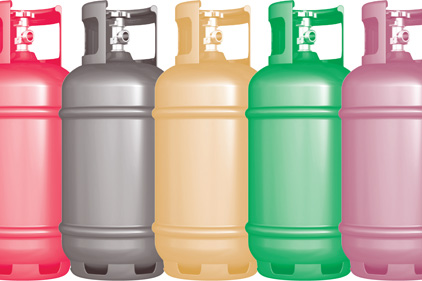 A 1965 folk song by Donovan waxed poetically about colors such as yellow for his true love’s hair, blue for the sky, and green for sparkling corn before veering off to non-colors like mellow and freedom.
A 1965 folk song by Donovan waxed poetically about colors such as yellow for his true love’s hair, blue for the sky, and green for sparkling corn before veering off to non-colors like mellow and freedom.
The refrigerant aspect of the HVACR industry has its own attachment to colors when it comes to cylinders. But while Donovan’s color palette was designed for literary lyricism, HVACR’s color usage may be considered a bit more confusing. HVAC cylinder colors creatively extend beyond the basic palette, utilizing terms such as light green, battleship gray, and rose for such familiar refrigerants as R-22, R-134a, and R-410A. And they can become even more descriptive as new refrigerants come to the market like pinkish-red (coral) for R-401A; yellow-brown (mustard) for R-401B; and cream for R-407B.
Reclamation canisters skip to the other side of the ledger and seem to stay grey, with color tweaks in the collars, shoulders, and caps. And, did we mention that the kaleidoscope of colors used to identify cylinders in Canada is totally different?
Starting Point
Two published guidelines may help sort out the color-coded language of refrigerants.
Air-Conditioning, Heating, and Refrigeration Institute (AHRI) Guideline N, “2012 Guideline for Assignment of Refrigerant Container Colors” contains a listing of 37 refrigerant colors. The purpose, according to the document, is to “establish assignment of refrigerant container colors; definitions; basic considerations for developing the color guideline; and assignment criteria.” And, as noted by Ted Atwood, president, Polar Technology, “AHRI Guideline N correlates to Standard 34-2010 from ASHRAE, ‘Designation and Safety Classification of Refrigerants.’”
The second document is AHRI Guideline K (I-P), “2009 Guideline for Containers for Recovered Nonflammable Fluorocarbon Refrigerants.” It states, “Recovery, recycling, and reclamation of certain nonflammable fluorocarbon refrigerants will prevent unnecessary release of these compounds. For practical and safety reasons, there is a need for containers designed and identified specifically for these uses.”
The concern of the standard is not regarding a wide variety of canister colors, but the colors of specific parts. For example, the document says, “Cylinders with nonremovable collars: The body should be gray. The collar should be yellow. Cylinders with removable caps: The body should be gray. The shoulder and the cap should be yellow. Drums: The drum should be gray. The top head should be yellow. Ton Tanks: The body should be gray. The ends and chimes should be yellow.”
Strictly Voluntary
A key element is that the guidelines are not mandated. AHRI acknowledges that as well. Guideline N says, “This document is intended as a recommended guide of good practice to be used on a voluntary basis by all who supply, use, store, or transport these containers.” Guideline K (I-P) states, “This document is intended as a recommended guide of good practice to be used on a voluntary basis by all who supply, use, store, or transport these containers.”
There is a rationale for the color schemes, said Maureen Beatty of National Refrigerants. “The guideline takes into consideration many factors when determining a cylinder color, including the class of the refrigerant so that the same color is not assigned to more than one refrigerant in a class. Guideline N also tries to consider the economic impact of painting cylinders when assigning a color. ... Exotic colors can be expensive and therefore prohibitive to use, so the guideline tries to keep it simple but as practical as possible.”
Gordon McKinney, vice president and COO, ICOR Intl. Inc., added, “In regards to new refrigerant (virgin and/or reclaimed), once a refrigerant producer chooses a specific pantone matching system (PMS) color code for their refrigerant, all producers should use that color on the disposable and refillable cylinders, so as to avoid any cross mixing or misapplication issues.”
That also goes for charging systems, as noted by Jay Kestenbaum, senior vice president, sales and purchasing for Airgas Inc., who said, “Refrigerant cylinders are colored differently for trade convenience. Since there are so many different types of refrigerants and systems, color coding the cylinders was adapted so technicians would not charge a system with the wrong refrigerant.”
Canadian Aspect
There is a bit of a variation in terms of how canisters look in the U.S. and Canada.
Marie Li-Ying, Canadian sales representative, Honeywell Intl. Inc., said, “Manufacturers in both the U.S. and Canada follow the ASHRAE color standard. In the U.S., the cylinders are painted with the ASHRAE color. In Canada, just the labels are colored.”
Jim Thomas, president, Refrigerant Services Inc. of Canada, offered further thoughts from the Canadian perspective. “At one time, refrigerant manufacturers followed the guideline and cylinders were all painted according to the guideline, but with the proliferation of refrigerants in the last 10-20 years, it was getting difficult to come up with distinct colors for all. We now have about 60 commercial refrigerants and most fluorocarbon refrigerant manufacturers now have white cylinders with colored labels or colored plastic protectors or even cardboard boxes in specific colors. Colors are still assigned by AHRI if the manufacturer requests it and certain PMS colors can be asked for if not already assigned.”
Read the Label
And, of course, the familiar direction “when all else fails, read the label” takes on special significance in the case of cylinders, as well as the importance of buying from reputable sources.
Kris Crosby, technical service engineer for fluorochemicals, Arkema Inc., said, “The color of a refrigerant cylinder should never be relied upon to determine the type of refrigerant in the cylinder. The best way to prevent purchasing illegally imported refrigerants is to only purchase refrigerant from a reputable supplier.”
DuPont also commented on the value of proper colors on canisters as part of the illegal import equation. Elizabeth Sassano, global refrigerants marketing and brand protection manager, said, “In addition to misspellings, wrong font sizes, and incorrect weights specified on the cylinder, wrong cylinder color/shade is another indicator of potential illegally imported and/or counterfeit products.
“Because of this, cylinder color can and should be one of the checkpoints when identifying illegal imports or counterfeits. If the color of the cylinder, packaging, or label appears to be inconsistent with the industry color standard, this should be a red flag that there is the possibility that the refrigerant content is not as labeled.”
Also noting the situation of illegal imports, Brad Halford, director of marketing, Polar Technology, said, “Currently, there is no color designation in illegally imported refrigerants. There are a number of indications that illegal importing of refrigerants is on the rise. To prevent this from happening, make sure your refrigerant source has the appropriate certifications, has high-quality standards, and can show you the appropriate purity level for the refrigerant you are purchasing if it is reclaimed.”
As a contractor, the simple takeaway is to read the label, know your colors, and know your suppliers.
Publication date: 2/10/2014
Want more HVAC industry news and information? Join The NEWS on Facebook, Twitter, and LinkedIn today!



Report Abusive Comment